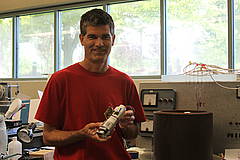
Tom Ekkens, chair of the Department of Physics at Walla Walla
University (WWU), has built an instrument that examines things as tiny as 7
nanometers by using a handful of basic, everyday materials. Usually, a device
with this ability is commercially available for thousands of dollars. Called a
scanning tunneling microscope, Ekkens found a way to achieve similar results
for less than $100.
 One day, as the physics professor was walking through Home
One day, as the physics professor was walking through Home
Depot, he walked past a section of PVC pipes. He stopped to look at the
different kinds of plastic piping, especially the small couplers for repairing
pipe leaks. Suddenly, he had an idea: I
could use these to see atoms!
Biological microscopes, or optical microscopes, are often used
for the examination of molecular samples. This involves a glass slide that
holds the sample and an upward-facing light shines through the sample that
magnifies the image through the viewing lens. This method uses small bits of
light called photons to view the sample. Optical microscopes are ideal for
viewing intricate details that are larger than one micrometer, the size of a
red blood cell. Anything smaller than that is difficult if not impossible to
see on an optical microscope.
“The type of microscope we use depends on what size of sample we
are looking at,” Ekkens states. “Things that are on the nanometer scale need to
be viewed with something other than an optical microscope. We use a device
called a scanning tunneling microscope.”
A scanning tunneling microscope uses electrons, instead of
photons, to view a sample. This enables the instrument to look beyond the
millimeter and micrometer level and reveal details from the nanometer and
atomic levels.
The scanning tunneling microscope that Ekkens has built is
composed of several pieces of PVC pipe, which make up the body of the
microscope. The sample is placed on one end and a tiny motor is connected to
the other end. The motor enables the sample to be moved on the macroscopic
scale. To generate movement on the microscopic scale, Ekkens uses a guitar
amplifier pickup, cut into four pieces, for effective control of the tiny metal
tip. These pieces are hot glued together and wires applied to connect it to the
metal tip. When current is applied through the instrument via external battery
pack, the tip flies across the sample and measures how many electrons pass from
the metal tip to the sample. This is the scanning and tunneling action.
Some other necessary parts include a controller for the motor, a
circuit board to channel the voltage appropriately, cables to connect the unit
to a computer, and a data acquisition card for the computer to process the
incoming data. An integral part of the homemade microscope’s use is a computer
program, written by Ekkens, to analyze data and convert it into images.
The Department of Physics has two commercial scanning and
tunneling microscopes, which are regularly used in physics laboratory sessions.
Ekkens appreciates these state-of-the-art instruments but saw limitations in
how most people use them. When he joined the Department of Physics at WWU, he
wanted to challenge his students by having them learn the science behind the
industry-standard devices by creating simplified versions of the microscopes
themselves.
Students build their own scanning and tunneling microscope in
three laboratory sessions, or about nine hours. Each year, students engage in
an unofficial competition to see which group has the best resolution. The
current record was set during Winter Quarter 2014, with a microscope imaging a
small bump that was 160 atoms wide.
“It is my goal in this class to help my
students realize that they can build something that does extraordinary things
out of common parts,” Ekkens states.